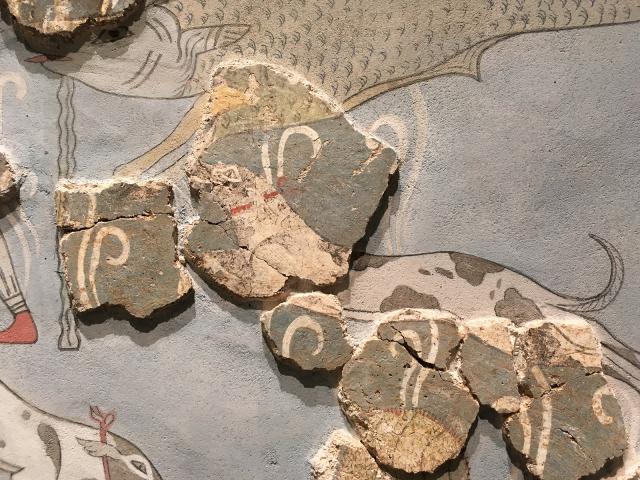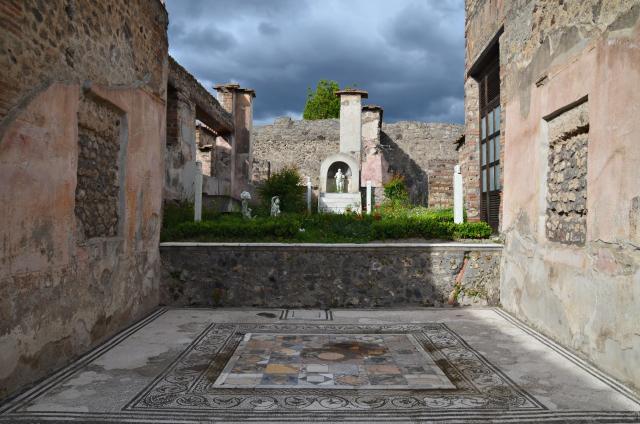Professor Emily Egan and Mekayla May to present papers at Archaeological Institute of America (AIA)
January 03, 2024

Professor Egan and Mekayla May present cutting edge scholarship at this month's AIA conference in Washington DC
The Department is proud to announce that Professor Emily C. Egan and PhD student Mekayla May will be presenting papers at the annual conference of the Archaeological Institute of America in Chicago (January 5-7).
Professor Egan will kick things off Friday morning at an 8 am session, while Mekayla will present during the afternoon session block (2-5) on Saturday.
Presenter: Emily C. Egan
Title: Counterpoints to Koine in Mycenaean Painting
Abstract: The existence of shared visual elements in the figurative art of Mycenaean Greece is undeniable. Across the known corpus, scenes and motifs repeat with frequency, with palaces being the favored locations for display. Never, however, are artworks from different sites truly “twinned.” This is especially clear in palatial wall paintings, where each depiction of a common theme, be it a procession, a presentation, a hunt, a battle, a lion and griffin, figure-eight shields, marine life, a patterned grid, etc., comes with a unique package of formal details, associations, techniques, context, and chronology. Further, it is never the case that all themes are represented at all sites, nor is it the case that shared types represent the whole of a palace’s artistic program. Disparities like these, often downplayed in the hunt for overarching trends and patterns in palatial culture, pose a significant challenge to the concept of a Mycenaean “koine,” a phenomenon underpinned by expectations of homogeneity. Using case studies from the seven attested mainland palaces (at Pylos, Mycenae, Tiryns, Thebes, Gla, Orchomenos, and Ayios Vasileios), this paper argues that, in the case of paintings, such expectations of homogeneity are simply not met. Instead, formal differences in the representation of common themes, as well as differences in where, when, and with what they were displayed attest to both the simultaneous presence of true and frequent artistic innovation in the late 14th and 13th centuries B.C.E., and the absence of inter-palace consensus about the meaning and utility of certain iconographies. While changes in representational style need not alter the fundamental character of a shared scene, if that same scene, as a core element of a larger iconographic vocabulary, lacks a stable meaning, can we really speak of a “koine”?
Session: Session 1F: The Mycenaean Koine in Context: Disentangling Material Uniformities in the Aegean Late Bronze Age (Colloquium); Friday, January 5, 8-10am
Presenter: Mekayla May
Title: A Welcoming Motion Picture for a Roman Guest: An Experiential Approach to Pompeian Oscilla
Abstract: Roman oscilla are double-sided marble reliefs suspended in the intercolumniations of predominantly domestic atria and peristyles. Prior scholarship has overlooked the object’s animation and viewer engagement, decontextualizing the oscillum from its role within the Roman house’s social nuclei of the atrium and peristyle and understanding them as complementary decorations to the space overall. However, oscilla played a crucial role in facilitating conversations and actions that showcased
one’s erudition and civic participation. This paper argues that the iconography of these suspended, double-sided artifacts goes beyond standardized Dionysiac imagery and garden ornaments. The oscillating and static nature of the oscillum guided viewers through their social responsibilities and cautioned them against disrupting the societal order within the Roman house. The variations of common compositions and figures visually and mentally stimulated the Roman viewer as he waited in the reception spaces of the atrium and peristyle to conduct business with the head of the household.
This paper employs an experiential approach to study the form, context, and disposition of oscilla by examining the oscilla programs of two Pompeian houses. At the wealthy House of Marcus Lucretius, the oscilla in the peristyle provoked theatrical participation and recollection through the imagery of solitary masks and instruments; the oscilla were a primary mode of tempting viewers to don the theatrical masks and adopt social roles that elevated the elite head of household. At the sub-elite House of Fortune, a freedman commissioned one of the most significant programs of oscilla for his peristyle, albeit in poor quality. The intentional pairing of images of conflict and cooperation on the oscilla promoted the patron’s social and civic participation to his visitors. The oscillum, as a distinct suspended and double-sided decorative piece, merits examination as part of Roman decor, shaping and being shaped by social interactions within a space.
Session: Session 6G: Recent Research on Houses at Pompeii and Oplontis
Congratulations and good luck!



